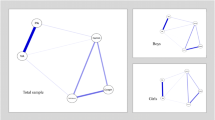Abstract
A number of investigations have reported that depressive and aggressive behavior are correlated in children. However, this relation actually may represent an association between the more broadband constructs of internalizing and externalizing problems. Three hundred fifty third through sixth graders and their teachers completed measures assessing aggression, anxiety, hyperactivity, and depression. Results of a second-order confirmatory factor analysis suggested that the relation between aggression and depression in fact may represent a more broadband relation between externalizing and internalizing problems. These findings may have implications for understanding of the causal processes underlying the relation between aggression and depression in children, and more generally, for our conceptualization of the nature of the comorbidity of depression and aggression.
Similar content being viewed by others
References
Achenbach, T. M. (1991).Integrative guide for the 1991 CBCL/4-18, YSR and TRF profiles. Burlington: University of Vermont Department of Psychiatry.
Achenbach, T. M., & Edelbrock, C. (1986).Manual for the Teacher Report Form and Teacher Version of the Child Behavior Checklist. Burlington: University of Vermont Department of Psychiatry.
Achenbach, T. M., & Edelbrock, C. (1987).Manual for the Youth Self-Report and Profile. Burlington: University of Vermont Department of Psychiatry.
American Psychiatric Association. (1987).Diagnostic and statistical manual of mental disorders (3rd ed., rev.). Washington, DC: Author.
Angold, A., & Costello, E. J. (1992). Comorbidity in children and adolescents with depression.Child and Adolescent Psychiatric Clinics of North America, 1, 31–51.
Bentler, P. M., & Bonett, D. G. (1980). Significance tests and goodness of fit in the analysis of covariance structures.Psychological Bulletin, 88, 588–606.
Berkowitz, L. (1983). Aversively stimulated aggression: Some parallels and differences in research with animals and humans.American Psychologist, 38, 1135–1144.
Berkowitz, L. (1989). Frustration-aggression hypothesis: Examination and reformulation.Psychological Bulletin, 106, 59–73.
Bollen, K. A. (1989).Structural equations with latent variables. New York: Wiley-Interscience.
Capaldi, D. M. (1991). Co-occurrence of conduct problems and depressive symptoms in early adolescent boys: I. Familial factors and general adjustment.Development and Psychopathology, 3, 277–300.
Capaldi, D. M. (1992). Co-occurrence of conduct problems and depressive symptoms in early adolescent boys: II. A 2-year follow-up at Grade 8.Development and Psychopathology, 4, 125–144.
Caron, C., & Rutter, M. (1991). Comorbidity in child psychopathology: Concepts, issues and research strategies.Journal of Child Psychology and Psychiatry, 32, 1063–1080.
Cole, D. A. (1987). Utility of confirmatory factor analysis in test validation research.Journal of Consulting and Clinical Psychology, 55, 584–594.
Cole, D. A., & Carpentieri, S. (1990). Social status and the comorbidity of child depression and conduct disorder.Journal of Consulting and Clinical Psychology, 58, 748–757.
Fergusson, D. M., & Horwood, L. J. (1989).Journal of Child Psychology and Psychiatry, 30, 365–378.
Fergusson, D. M., Horwood, L. J., & Lloyd, M. (1991). Confirmatory factor models of attention deficit and conduct disorder.Journal of Child Psychology and Psychiatry, 32, 257–274.
Gould, M. S., Bird, H., & Jaramillo, B. S. (1993). Correspondence between statistically derived behavior syndromes and child psychiatric diagnoses in a community sample.Journal of Abnormal Child Psychology, 21, 287–313.
Hymel, S., Rubin, K. H., Rowden, L., & LeMare, L., (1990). Children's peer relationships: Longitudinal prediction of internalizing and externalizing problems from middle to late childhood.Child Development, 61, 2004–2021.
Jöreskog, K. G., & Sörbom, D. (1988).LISREL 7: A guide to the program and applications. Chicago: SPSS.
Kazdin, A. E., Esveldt-Dawson, K., Unis, A. S., & Rancurello, M. D. (1983). Child and parent evaluations of depression and aggression in psychiatric inpatient children.Journal of Abnormal Child Psychology, 3, 401–413.
Kovacs, M., & Beck, A. T. (1977). An empirical-clinical approach toward definition of childhood depression. In J. G. Schulterbrandt & A. Raskin (Eds.),Depression in childhood: Diagnosis, treatment, and conceptual models (pp. 1–25). New York: Raven Press.
Kupersmidt, J. B., & Patterson, C. J. (1991). Childhood peer rejection, aggression, withdrawal, and perceived competence as predictors of self-reported behavior problems in preadolescence.Journal of Abnormal Child Psychology, 19, 427–449.
Landau, S., & Milich, R. (1985). Social status of aggressive and aggressive/withdrawn boys: A replication across age and methods.Journal of Consulting and Clinical Psychology, 53, 141.
Lefkowitz, M. M., & Tesiny, E. P. (1980). Assessment of childhood depression.Journal of Consulting and Clinical Psychology, 48, 433–450.
Loeber, R., Green, S. M., Lahey, B. B., & Stouthamer-Loeber, M. (1990). Optimal informants on childhood disruptive behaviors.Development and Psychopathology, 1, 317–337.
Panak, W. F., Garber, J., & Quiggle, N. L. (1989).Comorbidity of depression and aggression: Age and gender effects in a community sample. Paper presented at the biennial conference of the Society for Research in Child Development, Kansas City, MO.
Patterson, G. R., & Stoolmiller, M. (1991). Replications of a dual failure model for boys' depressed mood.Journal of Consulting and Clinical Psychology, 59, 491–498.
Peterson, L., Mullins, L. L., & Ridley-Johnson, R. (1985). Childhood depression: Peer reactions to depression and life stress.Journal of Abnormal Child Psychology, 13, 597–609.
Pope, A. W., Bierman, K. L., & Mumma, G. H. (1991). Aggression, hyperactivity, and inattention-immaturity: Behavior dimensions associated with peer rejection in elementary school boys.Developmental Psychology, 27, 663–671.
Puig-Antich, J. (1982). Major depression and conduct disorder in prepuberty.Journal of the American Academy of Child Psychiatry, 21, 118–128.
Quiggle, N., Garber, J., Panak, W. F., & Dodge, K. A. (1992). Social information processing patterns in depressed and aggressive children.Child Development, 63, 1305–1320.
Rose, S. L., Rose, S. A., & Feldman, J. F. (1989). Stability of behavior problems in young children.Development and Psychopathology, 1, 5–19.
Spielberger, C. D. (1973).Manual for the State-Trait Anxiety Inventory for Children. Palo Alto, CA: Consulting Psychologists Press.
Werner, H. (1948).Comparative psychology of mental development (rev. ed.). New York: International Universities Press.
Author information
Authors and Affiliations
Rights and permissions
About this article
Cite this article
Weiss, B., Catron, T. Specificity of the comorbidity of aggression and depression in children. J Abnorm Child Psychol 22, 389–401 (1994). https://doi.org/10.1007/BF02168081
Revised:
Issue Date:
DOI: https://doi.org/10.1007/BF02168081




